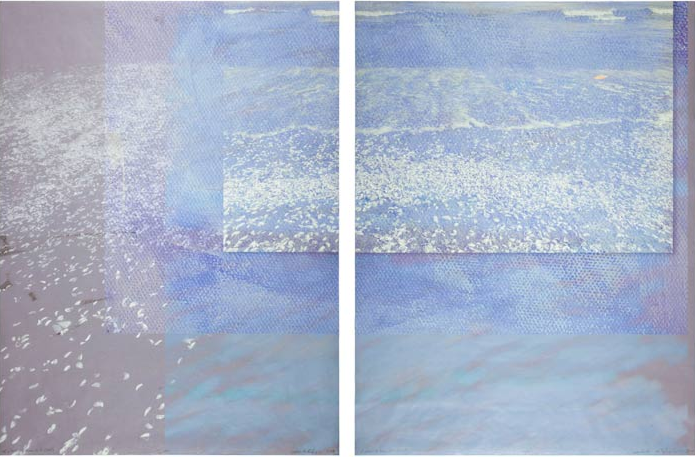Michelle Hegyi
Of Place & Time
Michelle Hegyi’s much sought-after work is currently on exhibit at WSG gallery. People are fascinated by her work when they see it at the gallery. The coating of encaustic on her pieces gives them a tactile surface quality that simultaneously echoes of thin veil and silken lining. Hegyi layers images and marks in a way that begs the viewer to look closely, then back up to take in the whole piece. From afar, the pieces have a feeling of serenity; up close the marks and textures create an active surface.
Visitors to the gallery always have many questions about how Hegyi makes her work. Below, she explains her technique in her own words.
Technique :
Much of my work is ‘created by hand’ on the computer, but has the look and feel of real paint. I find the computer enables me to experiment and to learn from an infinite number of color, value, line and space permutations, still allowing for the history of a piece to show through the layers. Using brushstrokes and other elements and sometimes whole layers from previous work helps to connect each work to the other. The happy accidents of chance combinations are an added bonus. In the last few years I have used the encaustic medium to add to the luminous quality of my work.
When I’m satisfied with the piece, which up until now, has only existed on the computer, I then print the piece myself on my Epson 9800 wide format printer to be sure I’m getting the desired colors, using Epson’s archival pigment ink on Moab Unryu 55 paper (a Japanese inkjet printable paper made by Awagami in Japan) which I buy on a 44” wide roll from B&H Photo and Video or Adorama Photo. Afterwards, using a hot palette, I infuse the print with melted encaustic medium that I’ve made myself using beeswax and damar resin (from R&F Encaustics). The transparent encaustic medium enhances the digital layering and gives the piece a unique luminous quality, as the light filters through the wax. It also makes the Japanese paper and the colors transparent — so I then paint the back of the piece with white acrylic paint which removes this transparency and enhances the colors as seen through the wax. The final piece can either float one inch off the wall using small magnets mounted onto clear plexiglas strips or alternatively the work can be floated in whitewashed maple museum quality frames from Metropolitan Picture Framing in Minneapolis, Minnesota.
I like to use Metropolitan whitewashed maple frames to float my pieces, using magnets to hold the pieces in place on the white Rising museum board. The magnets are necessary since hinging tape cannot be used on the backs of the pieces — the tape would remove the fragile but stable white acrylic paint layer from the back of the piece.
— Michelle A. Hegyi



